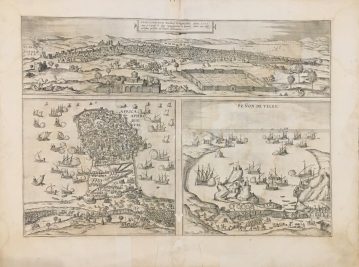Tunis, Mahdia and Penon de Veles.
Braun and Hogenberg.
Synopsis
The view is made after an engraving by Giovanni Francesco Camocio, c 1570.
TRANSLATION OF CARTOUCHE: Tunis, town of the Berbers and royal seat, drawn true to life in 1535 by Johannes Maius, His Majesty’s court painter, following its capture by Emperor Charles V.
COMMENTARY BY BRAUN: “There are many cloth weavers in this town, for the women normally do nothing else but spin very fine and delicate thread, the cloth made from this is traded all over Africa and fetches high prices. … There is no river, no spring or sea; thus the inhabitants make use of rainwater, which they collect in cisterns. Only on the outskirts of town is there a saltwater spring, out of which numerous carriers bring the water into town to sell. Otherwise there is also a freshwater lake, but this is reserved for the princes and courtiers.”
MAHDIA (AL-MAHDIYA)
CAPTION: Africa, once called Aphrodisium.
COMMENTARY BY BRAUN: “Aphrodisium, which is now commonly called Africa, but by the Moors Mahdia, lies in the sea … The acces from land is so formidably fortified with immense towers, labyrinthine walls and outfitted with tower galleries and hideouts that it stretches the powers of the imagination. Hence the Moors considered it unassailable.’
The bird’s-eye view depicts the Peninsula of Mahdia, Aphrodisium or Africa in the throes of deadly battle on the water and on land. In 1546 the pirate Turgut Reis, following the death of Admiral Khair ad-Din, called Barbarossa, became the new commander-in-chief of the Ottoman naval forces. He besieged and plundered such places as Sicily and Calabria and attacked the Spanish bases in North Africa. In 1549 he captured the town of Mahdia, supremely protected by defensive labyrinthine walls. The plate depicts the massive recapture at sea and on land by the Spanish Admiral Andrea Doria and the Maltese Claude de la Sengle in September 1550. Mahdia, or the Horn of Africa, is located on an ancient site, which in the 16th century was thought to be Ptolemy’s Aphrodisium.
PEÑON DE VÉLEZ DE LA GOMERA
COMMENTARY BY BRAUN: “Peñon de Vélez is a very old town on the shore of the Mediterranean; it was called Velles de Gumenera or Pennon de Velles by the Spaniards and more than 600 families reside there. It is located between two high mountains. Fresh water is a rare commodity for them since they must all use a watering hole located on the outskirts of town. The citizens are divided into two groups: many of them are fishermen, the others are pirates, who brings the Christians great misfortune.”
The plate depicts a small rocky island under siege cannon fire from the land as well as from the sea. Fortifications with towers, walls and planted flags can be identified on the sheer cliffs of the island. The Spanish, battling the resident pirates there, initially captured the island in 1508. Afterwards it fell under Moroccan rule for 42 years until the Spanish won it back 1564. Because the island was occupied constantly and difficult to hold, it was allegedly blown up in 1871. (Taschen)






